Tilapia fish is a popular choice for starting a small scale fish farming business. From the ancient age, people have grown tilapia fish on their farms. This farming is known as a commercially successful business. However, as with grass carp farming, this farming can change your fate. There are several methods to cultivate this fish. Here we tried to focus on the most beneficial process which will improve its productivity.
Tilapia are warm water, hardy fish. That is why it is easy to grow. Besides, you can easily farm them in fish culture systems. That makes it one of the best small-scale aquaculture, from sizeable commercial production to small backyard ponds.
If you’re interested in starting a tilapia fish farming business, this guide will provide you with all the information you need to get started. We’ll cover everything from choosing the right tilapia species for your farm to constructing the perfect tilapia pond.
How to Start a Tilapia Fish Farm

It is necessary to have proper knowledge about tilapia culture, the design of ponds or tanks, and water and feed management. Besides, it is essential to have adequate ponds or tank designs. That will allow efficient control of the water environment.
Your profit on this farming will depend on how well you can water the water quality. In addition, the tank where you grow fish should have drainage for harvesting and maintenance.
Besides, your farming success will depend on aeration and frequent or continuous water exchange. Moreover, the quality of the feed will allow the fish culture to grow well.
The culture of Tilapia is currently a very profitable farming business. Two types of breeding are the most important: intensive and hyperactive intensive. We discuss the whole process below.
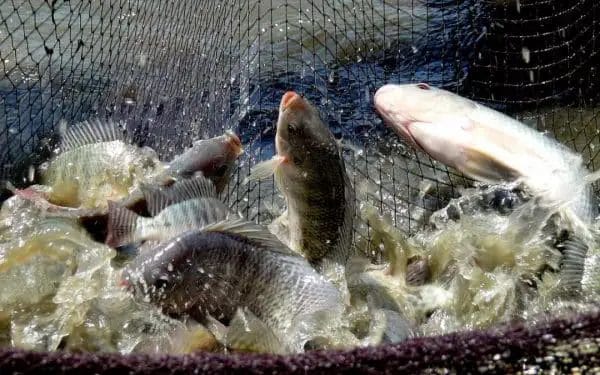
Best Tilapia Species to Start With
Tilapia can be discovered in lakes, ponds, marine habitats, watercourses, estuaries, and seafaring conditions. They favor tropic conditions with water temperatures in the 25-30 ºC range. Some varieties can tolerate cold colds down to 8 or 9 ºC.
| Name | Short Description | Reason/ Whether |
| Nile Tilapia | The ancient species from Egypt. After five to seven months at approximately 1-2 pounds. | Anywhere,
Water type: Fresh lake water. |
| Blue Tilapia | Gain 2-4 pounds in a year. | Northern Africa and the Middle East, USA, Part of Asia. Grow in cold temperatures also
Water: Fresh and Saltwater |
| Mozambique Tilapia | Can reach over 2 pounds in a year. | Can’t grow in cold or salty water. |
| Andersonii | The best-tasting species with a small head. | Suitable for cool-water culture. |
| “Abbassa’ and ‘Akosomb’ | Hybrid from Nile Tilapia | Grow 30% faster. |
| Rendalli | Largely herbivorous | Attractive for the aquaponics industry. |
| Monosex Tilapia | Hybrid. Grow very first in the pond twice a year. | India, Bangladesh, South Africa, USA |
| GIFT | Gift variety has an 80% higher growth rate and a 50% higher survival rate. | Across the world |
Things You Need to Know for Grow Tilapia [Starter Guide]
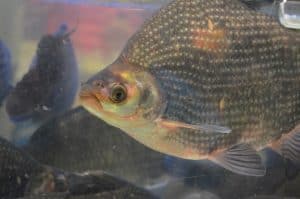
In this guide, we’ll go over the primary and advanced things you need to know before you start harvesting. Learning about this will help you to be a successful tilapia fish farmer. We’ll try to discuss all the materials you will need to acknowledge. Let’s start by learning the basics.
The tilapia is a freshwater fish that is native to Africa. There are about 100 different species of tilapia, and a few of them have already been identified as being able to be cultivated, including the Nile and red tilapia. This is because they are able to produce more offspring in shorter-depth tanks in less time.
Where You Can Grow Tilapia Fish?
Grow tilapia fish possible in various conditions, including fish ponds, cages, raceways, and tanks. Residential producers have even started growing them in trash cans.
But if you like to grow tilapia fish for profit, you need a set of ponds or tanks. Depending on your budget, it could vary from 8 to 12 tanks or even more. However, you can have one backyard pond to start growing.
How Fast does Tilapia Grow?
Tilapia are among the fastest growing freshwater fish. They reach full maturity at 6 to 8 months (under proper growing conditions). They grow to about 18 inches (45 centimeters) in length and 1. 2 pounds to 2 pounds (600-900 grams).
Besides raising fish for food, you can also breed them for fry and fingerlings to “reseed” your fish crop in the future. It usually takes one female tilapia between four weeks and four months to spawn, depending on the species. It doesn’t matter how low the survival rate is, you will still have tilapia fry in just a few weeks.
How to Secure The Profit?
To secure profit, firstly, you must understand the problems related to these farming methods. It is essential for starting up successful commercial farming. We have some issues on our farm.
Here are some issues that we have on our farm.
So we decide to talk to other successful tilapia fish farmers. As Soon, The modern farmer’s blog reaches those farmers; they help us write the best tilapia fish farming article. The common causes of failures are:-
- To many fingerlings: The tilapia fish is very productive in terms of breathing new baby fish. That may create unwanted situations. The female spawns about 200-1000 eggs after every 4-6 weeks. Do you afford that? To feed or grow?
There is a solution to this- Monosex Tilapia Farming Method, which allows us to farm only male tilapias.
- Lack of nutrition: Generally, people do not have the proper knowledge of age-based food. We will give you an acceptable guideline on that.
- Selling Problems: Again, this is a very commonly done mistake that most farmers misunderstood. As with any other fish, tilapia fish have quick growth stages and slow growth stages.
Let’s think that,
You have some fish in your pond. Now they will require food and spices if they don’t grow weight any time soon. But you are feeding them. As they are not growing weight, your foods are being wasted. So what can you do? Read Catching / Harvesting [ How & When].
Ensure the quality of water and nutrients
Water is one of the most important things. As you know, Tilapia can survive in dirty water. You don’t want to produce poisonous fish in your firm. Bacteria, viruses, pathogens, and other infectious organisms are harmful to the human body. So it will be wise to provide fresh water to your pond or tanks.
What about nutrients?
General Food Cart for Tilapia. Divide the total amount of food needed with serving time. Make sure you don’t waste any feed.
| Assumed-size of fish | Amount of Feed per day /per fish | Approximate Time after stoking | Times a Day |
| 5-40 g | 1g | 1-2 month | 3-4 |
| 40-100g | 2-3g | 2-3 month | 3-4 |
| 100-400g | 3-4 g/fish | 3-5 month | 3 |
| 400+ | 4-5 g/fish | 5 months + | 3 |
Tilapia pond design [ Adapt circular Containers]
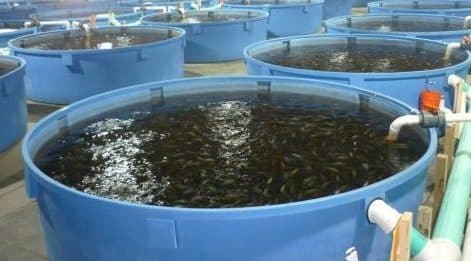
In an ideal farm model, you require eight circular ponds/tanks. In the cultivation systems, there are two types of aeration. These are vertical and horizontal. The first sheer creation goes from the bottom to the surface. This type of aeration gives to us by an apparatus. That is aquaculture called blower—this system is used in the first stages of cultivation.
Since you see the fish until they weigh 45 grams, this stage can store 180 to 200 tilapia fishes per cubic water meter. And, It represents 14 to 16 thousand tilapia fishes per pound. This weight will require two additional tanks to the first one. In the second stage, 85 and 100 animals are handled per cubic meter. This is where the horizontal aeration type is required.
Note: Circular tank pond is recommended, not essential.
Divide the container for better production
It is this factor that determines the fastest growth of Tilapia in commercial cultivation. If you have eight containers – with four of them, you could have a constant, uninterrupted production. So you can expect to profit about once a month. Then start with half of the pond/tank, then another month, another half, and so on. If you tried to increase the number of ponds, it would still be in multiples of four.
In the Tilapia farming system, the fish depends entirely on feed. In this system, you do not need external aeration systems. Only an efficient water exchange when required. The crucial point is that any of the two farming systems. It is essential to have a monosexual tilapia. Therefore, there is unwanted reproduction. Since Tilapias are very early, and after two months, they begin to reproduce and could leave the producer far from profitability.
Standard tilapia fish tank/ pond size
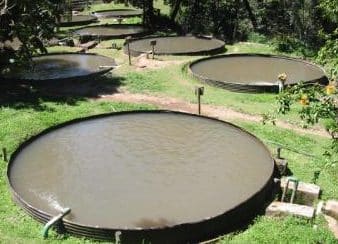
Now, a pond should be 20 by 40 meters. The standard size is 800 square meters. The depth that we are going to have is 1 meter, 20 centimeters. It represents 960 cubic meters of water.
But:
If we handled ten Tilapia per cubic meter, 9600 fish would be stored in this Pond. The most important when growing tilapia fish is the balanced feed. It is estimated that 1.7 kilograms of food would give to harvest a kilogram of meat. Therefore, it is essential to know the ideal weight of harvested Tilapia is 500-600 grams. In the standard Pond, we estimate to produce 4800 kg. That means a total of 9600 Tilapias which are 4800-5500 kilograms of product.
Note: The adult tilapia fish weight is between 1kg-4 kg. To achieve adulthood they may require 2-3 yr.
Commercial Farm Setup
- Initial Tank size for fly – 16 m x 3 m x 0.75 m.
- The Final Tank size: Circular culture tanks 12 to 30 feet and 4 to 5 feet in dept. For others, the length to width to depth ratio should be 30:3:1.
- Number of tanks – 4
- Covered by fine hanging mesh.
Water PH Level
The pH level needs to be favorable for fish farming. If the pH level of the water is 8.5-9.0, it is convenient for fish farming.
If the pH is higher than 9.5, it is inconvenient for fish farming because free carbon dioxide is not available in this condition, so initial production can’t take place. On the other hand, a pH of less than 7.5 is not good for fish farming as it reduces the appetite of the fish and reduces growth.
Dissolved Oxygen
There are different gases dissolved in water. Oxygen is the most important of them. Oxygen in water comes from the air and through the photosynthesis of the vegetable panton. The amount of oxygen for fish farming should be more than 3.0 ppm.
Carbon dioxide
If the amount of carbon dioxide in the water is high, the amount of oxygen will be less, and hydrogen sulfide and other toxic gases are formed at the bottom. Without it, if the carbon-di-oxide in the water is high (20 ppm), the water becomes acidic.
Primary Cost for Starting a Small Scale Business Aquaculture Tilapia Farming
This small-scale or more significant business depends on the production system. If it is floating fish cultivation, it requires a lower investment. The Cost of the building calculates one hectare in a floating area. The production capacity for 20 tons of Tilapia the Cost per year corresponds to 5 thousand dollars.
Look:
Usually, a floating cage (continental water conditions) is 20 meters in diameter and three inches in depth. It cost 4 thousand dollars. It produces 60 tons of biomass per year.
The cost distribution is 55% for the balanced feed, 8% for fingerlings, and 37% for production and administrative costs.
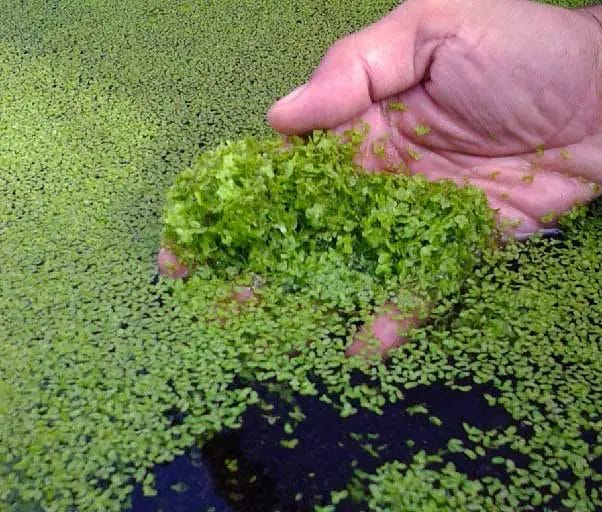
Homemade organic tilapia feed
To grow tilapia fish, you either buy feed from the local market or make feeds in your house as they eat everything frequently. Homemade pellets are one of the best for feeding. It is created with Rice Bran, Corn, Oat Groats, Canola Meal, Alfalfa Meal, or Linseed Meal, along with vegetables.
You can give those feeds directly to your tank. It will damage the water very quickly. So we suggest buying meals for Tilapia until they are four months old.
Feeding methods for a Small Tilapia Fish Farm
The average survival of the fish was determined by 99%. The growth of tilapia fish will be around 960 grams per organism. To achieve this result, the researchers modified feeding the microorganisms—the amount of food determined by the percentage of biomass.
Our recommendation is to give a balanced feed to the fish.
- This should be floating composed.
- It is flours of vegetable origin.
- That can be soy, corn, wheat-soybean oil, fish, vitamins, and minerals.
This is the deal:
As the fish grow, the level of protein in the food decreases. This ranges from 38% for small fish to 24% for commercial size fish.
The best time for entrepreneurs to harvest and the market is during Lent and Holy Week. The aquaculture industry is booming and is expected to grow by 40 percent by 2030.

Make an Appropriate Food ratio
The diet should contain containing vitamins and minerals. On the commercial farm, you can buy or make pellet diets. Feeding is the main cost.
There are several types of balanced foods. That can be used during the cultivation. However, initiating food for 1-to 25-gram fish is expensive. The food must contain 32 to 36 percent protein. It is close to $0.060 per kilo.
The rest of the food consumed costs around $0.50. The feed for larger Tilapia should contain 28 to 32 percent protein.
Therefore, the average cost during the whole tilapia farming is about $0.65 to $0.72.
Other costs can also add up, depending on the labor and transportation. The selling price varies from $.90 to 2.60 cents per fish. At the same time, the per kg value will be $2.20 to $6.60.
Initial Stage Feeding Tips
- Dosage of food application – up to satiety.
- Food application – 3 times a day.
- The water quality of this tank is maintained by regularly changing the cold freshwater.
- During their stay in the transient tank, the small fry is counted and transferred to the Pond.
If you want to place the fry in Hapa-
Hapa is a cage-like, rectangular, or square net impoundment placed in a pond for holding fish for various purposes.
- Hapa Size – Length 8 m x Width 2.5 m x 0.75 m.
- Feengerling per hapa – 2000 / cubic meter.
- Food application level – 20-50% of body weight.
- Food should be applied 4-6 times a day.
- Duration of feeding hormone mixed food – 18-21 days.
- By changing the water regularly, the water quality of the nursery hopper in the pond is maintained (temperature 24-296 Celsius).
Estimated feed required:
The most crucial matter to growing tilapia fish is the balanced feed. It is estimated that about 1.7 kilograms of food produce a kilogram of meat. For every hundred Tilapia, it needs 170kg of feed. Theoretically, the standard 100 fish weight is about 50-55kg.
Different Types of Tilapia Cultivation Methods
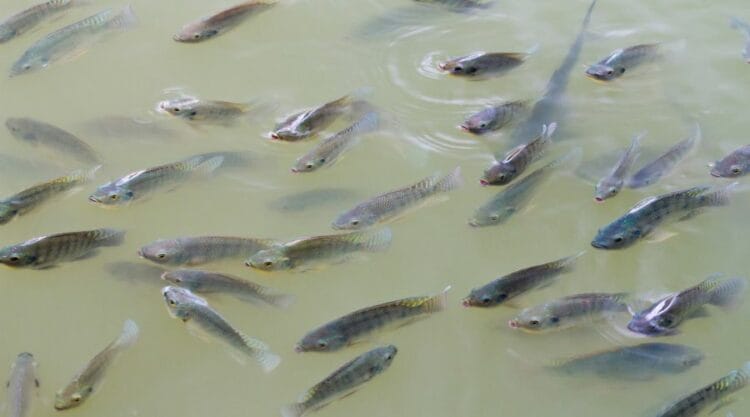
Every producer should consider the basic principles of aquaculture quantity, quality, and continuity of water. We will see what is required of water to use in each pond. Know if all the time you have the same quantity and quality in the water.
Once you maintain the quantity is with the continuity of the water. You can proceed to install your hatchery.
There are five ways to grow Tilapia: extensive, semi-intensive, intensive, hyper-intensive, and industrial. Intensive and hyperactive intensive crops are profitable. The difference between these two systems, one is made in a land pond. Above all, the other is in a pond of material.
Intensive cultivation
The biologist mentions that with a pond on land. There have to be at least four pounds of approximately 20 meters by 40. This shape is rectangular to grow tilapia fish.
Another critical point each one should have a slope. The floor should have a hill with an entrance and an exit separately. Stresses in this type of crop can handle 10 to 15 animals per cubic meter. It is to have the generalities mentioned.
Intensive Hyperactive Cultivation
The second method profitably is the hyperactive intensive. Here the ponds are circular. The system consists of a circular pond with a conical bottom. The ponds have a drain in the center. It would be best if you prepared ponds properly. Commercially there are four sizes of ponds.
The ideal is 9.40 meters in diameter, which holds about 80 cubic meters of water. And the ponds cost between $ 1200 – $1300.
Monitoring Procedure:

A great advantage is in the two profitable breeding systems. That is only one person needed to manage them. It requires monitoring the temperature, and oxygen levels.
This is essential to the concentration levels of ammonia in the system. There are commercial companies that sell this necessary equipment.
And if we want to recover the contained nutrients. You can execute it in the hydroponic culture. And, this phase of the research we have just started.
Most Production of tilapia:
The majority of Tilapia production is concentrated in the Columbia Dam. This is a department of Huila. Their production reaches 35,000 tons per year.
The second order is the Villavicencio area. The rest of the production is atomized in the other regions of the country. It corresponds to the first marine species to grow in Colombia.
This crop is made in floating cages in the open sea. It is expected to harvest about 400 tons this year—export fresh to the United States market.
Monosex Tilapia Fish Farming Method
Monosex tilapia fish farming is a method of only growing tilapia male fish. Female fish are reproductive. They give birth to about 200 – 1,000 fingerlings every 4-5 weeks, which take more than four-six months to become mature.
But the pain in the back is? If you have 100 females, it will give birth to 2000-10000 fingerlings. You dump! The solution to that is Monosex tilapia fish.
The big problem with tilapia farming is its uncontrolled breeding. Due to this kind of uncontrolled breeding, tilapia fish of different sizes can be seen in the pond. Due to this, the expected yield is not available. Naturally, the physical growth of male tilapia is higher. Using this idea, only male tilapia is called Monosex tilapia.
Most fish farmers are now interested in cultivating Monosex tilapia due to their habit of supplementation, less time to cultivate, faster growth, and higher market value.
Characteristics of Monosex Tilapia:
- Fast-growing and more productive.
- This fish becomes marketable at the age of 4-6 months.
- It weighs 500-600 grams in 5-6 months.
- The color of the fins is slightly reddish, the size is very round, and the market price is higher due to its thicker thickness.
- In general, the growth rate of male tilapia is 30 percent higher than that of female tilapia.
- This fish can also be farmed in shallow ponds, clear, and saltwater.
- It is a highly immune fish.
- Farm management is easy and the amount of profit is high.
Fry stocking and food management:
Collect 200-250 healthy strong fry weighing 15-20 grams per pond.
After stocking the fry, 25-30% protein-rich supplementary food should be stored in the pond every day. It should be applied at the rate of 3-10% of the total body weight of the fish.
The soybean meal can be used up to 10-20% by reducing the quantity of fishmeal and rice/corn husk available in the local market to increase the quality of food and reduce the price. In this method, the amount of fish meal can be reduced by 5% and the amount of meat meal can be increased by 5%.
Monosex Tilapia is cultivated in two stages. Nursery and reservoir pond. It is possible to get more production from the same pond in less time.
The food and caring method are like the above. You are just farming only male fishes.
GIFT Tilapia Cultivation Process
The GIFT (Genetically Improved Farmed Tilapia) Tilapia breed was first invented in the Philippines by the World Fish Center using the mass selection method of 6 germplasms of Nile tilapia collected from different countries. Experimental research has shown that the Gift variety has an 80% higher growth rate and a 50% higher survival rate than the native Philippine tilapia.
A special feature of the tilapia fish is that most of them lay their eggs in their mouths and the fry is supervised by their parents until they are accustomed to swimming, and based on this feature, fisheries scientists have divided them into several categories.
Genus Tilapia: They do not lay eggs in their mouths. Eggs are laid on the surface of the soil and hatched. E.g. Tilapia Zilli.
Genus Saratherodon: Only male fish lays eggs in its mouth, such as Saratherodon galihaeus.
Genus Oreochromis: Only the female lays eggs in the mouth of the fish, such as Oreochromis niloticus, and Oreochromis mossambicus.
The gift tilapia has already been shown to be 50-60 percent more productive than other tilapia in the country. It is undoubtedly an excellent species of tilapia for fry production and cultivation. Scientists now call it super tilapia.
GIFT tilapia farming benefits
- It is high yielding.
- The pond is marketable at a depth of 1 m in 3-4 months.
- It is possible to take three yield cycles every four months.
- They like any food.
- Is not easily diseased.
- Easy fry production is possible.
- Can be cultivated with little capital.
- Delicious to eat and high in market demand.
Depth and shape of the pond/tank
The depth of pond water should not be more than 3-4 feet for breeding and cultivation of GIFT tilapia.
A pond that dries up in summer but has 3-4 feet of water in the rainy season is good for breeding and cultivating tilapia. The pond should be rectangular for any fish farming. As a result, there is an advantage of fishing by pulling the net. The shape of the pond should be north to south so that there is adequate ventilation in the pond.
Necessary advice
- We recommend monitoring the pond for an hour after feeding the fish. This will help you determine if there is any issue with the pond or fish, or if more food needs to be given.
- Every 8-10 days, the amount of food should be determined by observing the growth of the fish by pulling the net.
- After stocking of fry, apply 250 gm of lime percent per month (lime should be soaked in water and applied cold) or 150 gm of zeolite.
- Many times in summer the water in the pond decreases and as a result, the water temperature rises. In this case, the required amount of water should be given to the pond.
- In case of continuous cloudy weather or excessive rain, the amount of food in the pond/cage should be reduced or feeding should be stopped.
Catching or Harvesting [ How & When]
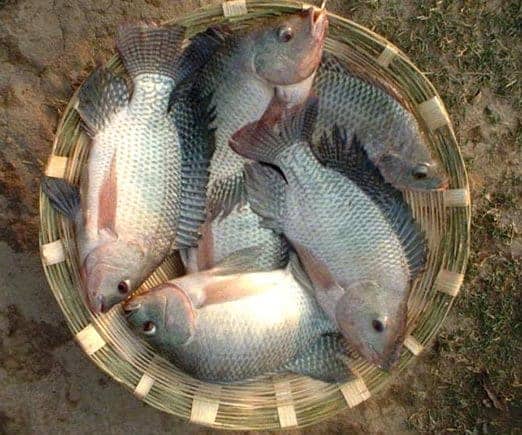
Tips to grow tilapia fish faster and improve productivity:
- When the fish reach 180 or 200 grams, divide the fish into different pounds. At this time, the fish will require more space to move.
- You can repeat the same process when they are about 300 grams. In the end, to grow Tilapia you will need eight ponds.
- A diet adjustment is needed after two of those above steps. This is crucial for improving productivity.
- When they gain weight of about 400g, put them into separate tanks.
Catching fish for sale:
If you grow tilapia fish, you will notice that they grow very first. That’s why raising them is profitable.
- Catching them for sale starts when they become 400g.
- But we recommend harvesting them when they become 500g because people found it more profitable.
Thanks. Please add your valuable comment below. In this post, we tried to focus on many aspects of growing tilapia fish. Let us know if you find this helpful.

Hi, well written post . Informative and well decorated. Lot of thanks from india. We love farming.
Nice
Thank you for sharing this valuable information.
Highly enlightening!Knowledge and technology sharing is so important for nutritional security. Commercial scale farming in tanks can take care of the demand supply gap in India. Will be happy if complete solution can be provided at the most competitive cost.
Hi
Hello!
Singing worship songs are sweet but that?s not the one approach to worship.? Daddy stated, possibly to make Larry stop singing.
?There are lots of ways to worship.
I love tilapia fish farming
I love tila pia fish farmin how can i start it
I love tila pia fish farmin how can i start it can i get funding on ot?
But wanna admit that this is extremely helpful, Thanks for taking your time to write this.
greatly thankful for your commitment of teaching and inspire people fish farming
God bless you all
iam starting a tank tilapia culture i need your guidance. You write up is very educative
I would like to start to farm tilapia so I would need all the help I could get
Here, we can help you.
i like your website it is very amazing. But is it possible to get your website in french? Sometime the knowledge in english of some people is not really good so it sometime difficult to understand completely what is saying! thank you and congratulation to you!
very interesting and gives enough information
Thanks for very informative guide in growing tilapia, it provides me contcrete ideas as a beginner grower.
Thanks for your appreciation
I grow tilapia naturally in a pond. I want to sell my fish, but the fish buyer says that I have to have a permit. Can you help me?
Tell me the details…
need modern agriculture information
I whant toe start a fish farm so what food can i produse to feed the fish
Self prodused
good article and informative about tilapia fish farming .
joy fish farm. cochin.
how much can you sell the fish for by average in american dollars??
The farm owners get 2$-6$ per Kg for the live fish. 1$-2$ (Kg).
The pricing varies due to the size/weight of the fish and the session.
Thanks a lot for the article post. Great.
Hi God bless you for the great message you have given us thanks I am going to start the process of tilapia farm and I know you will help me produce good ones thanks again
We are here to help. Just ask here.